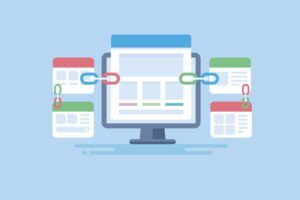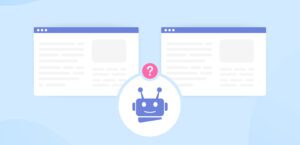
Proven ways to increase crawl efficiency

In the past, getting your website’s pages into the SERPs was relatively simple – with the help of a few technical SEO hacks up your sleeve, of course. But now it’s more difficult than ever.
This will come as no surprise, given the sheer scale of online content making every keyword increasingly difficult to rank for.
But it’s not all doom and gloom. Not at all – there are, in fact, a few neat SEO tricks that’ll help the speediness and efficiency of your website’s crawl.
Before we get into how to increase your crawl efficiency, let’s first just cover why it’s important in the first place (if you’re already clued up, do jump ahead!).
How content gets ranked by search engines
Before any webpage makes it onto the SERPs, it has to impress the search engine’s crawl bots.
The process is pretty simple:
- Crawl: A crawl bot known as a spider will crawl new URLs to kick-start the processing of its content. This crawl is an automated program, but website owners can also ‘request indexing’ through Google Search Console.
- Index: The crawled content is then stored and organised. Once a page is indexed, it doesn’t necessarily mean it will rank well – however, it is at least in the running to be, providing the content is deemed helpful.
- Rank: This is where SEO techniques come in to boost your page’s ranking in the SERP. Search engines will want to reward content that best answers the user’s query, meaning results are ordered from most relevant to least relevant.
In carrying out these primary functions, search engines use a crawl budget that you’ll want to optimise.
What is a crawl budget?
A crawl budget is simply the number of pages that search bots are willing to crawl on your site on any given day. This number is relatively stable, though it does vary slightly.
Now, crawl budgets are unique to each site, so yours will be your own. As a general rule, the main factors that will influence how much budget you have will be the size of your site, its ‘health’, and the number of links pointing to it.
- The crawl demand: AKA how much popularity (think backlinks and traffic) or how stale (or up to date) it thinks your site is – that’s why adopting a fresh content marketing strategy is so important.
- The crawl limit: AKA how fast the bot can access, navigate, and download your URLs. By giving it a limit, Google ensures that, in doing the crawl, your servers aren’t overloaded.
Our Technical SEO, Adam Chapman, explains a crawl budget below:

“Crawl budget relates to how many pages a search engine can crawl within a certain time frame. It’s often assigned based on two different factors: crawl limit and crawl demand.
Crawl limit refers to how much a site can handle and webmaster preferences.
Crawl demand is based on how often it recrawls a URL, which is dependent on how popular it is / how often it’s updated.”
TIP: If you want to find out your website’s crawl budget, simply go to Google Search Console go to ‘Crawl’, and then ‘Crawl Stats’. There you can see the number of pages Google has assigned to your budget.
Effective ways to increase the crawl efficiency of your site
Improve your site speed

The first step, you’ll want to increase your page speed. This is good practice in general, as a site that loads at a sluggish rate or appears buggy will only frustrate users and send them elsewhere.
Crawlers are like automated users, and they like the same experience as their human counterparts – a quick, easy trip around your site to get what the answers they were after.
The faster they can do their job, the more assets they can process as part of the crawl budget.
Audit your internal linking structure and further optimise
Crawl bots navigate around the web using either sitemaps or internal links.
For this reason, we can’t stress enough just how important a well-thought-out link structure is.
Ultimately, you’ll want to reduce the number of clicks that it takes for each page to be found. If it would take a human user 8 clicks to find an old blog post that you’ve just updated, then it would take the bots the same. This means you’re exhausting your budget – quite literally. That bot is spent.
Ultimately, you’ll want to reduce the number of clicks that it takes for each page to be found. If it would take a human user 8 clicks to find an old blog post that you’ve just updated, then it would take the bots the same. This means you’re exhausting your budget – quite literally. That bot is spent.
Fix any broken links
Similar to the above, broken links waste the crawl budget. In navigating your website, broken links impede site crawlability, sending the bot to dead ends. You cannot recuperate your day’s crawl budget, so regularly auditing your site and checking for broken links is a vital part of technical SEO.
As with the bot, broken links also frustrate the user in the same way. In conflating the bot with the human user experience, you’ll have a better way of understanding how Google programmes its algorithm.
Adam adds:
“Search engines traverse the web through links which is why it is vital that your website contains working links to other pages. A page with no internal links pointing to it may not be found by search engines.”
Avoid duplicate content
Duplicate content is an immediate red flag to crawl bots. Google wants your site to be original, and each page to have a purpose.
If the crawl bot comes across duplicate content, it struggles to decipher one page from the next. Even if the page titles and meta description tell it what you want the page to rank for, you’re giving it mixed signals.
Filling up your site in this way may have slipped by in the past, but Google is savvier now, and minimal effort means minimal gains. As with most things in life, skipping out on the hard work does not pay off.
What’s more, should your original page be ranking well, the duplicate copycats could start to cause SEO cannibalisation problems and disrupt its performance.
Need support to increase your site crawl efficiency?
If your website has taken a hit in Google’s Core Update in March 2024, get in touch and we’ll get you started with our Google Penalty Recovery Services.
FAQs
Answered by Amy Leach
Does Google crawl pages which haven’t been updated since the previous crawl?
As long as Paige is are linked too well on the website and crawlers are easily able to navigate around the site new pages and updates to pages should be picked up regularly. You can also submit these to be fetched within Google’s index by using Google search consoles inspect tool.
How fast will a newly uploaded page be indexed by Google?
How regulate your site is crawl by Google independent a lot of factors. if you have a large e-commerce store which is easiest will often come back on a daily basis to review all pages and navigate throughout the site. on the other hand if you have a smaller website which doesn’t have many external links and is not navigable by Google, this will be much less frequent
If a bot finds a broken link, is my SEO harmed?
It’s always preferable to have a clear website with no weed direct or broken pages. One broken link would not mean that your SEO is harmed or would be any detriment to performance. That being said we would always recommend a clean site where possible to ensure that crawlers can easily navigate through the website.

